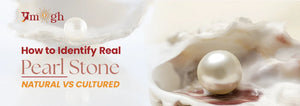Few gems have quite the same enduring beauty and enigma as the Pearl. While other gems are born in the fiery heart of the earth, a natural Pearl gem is an organic gemstone, slowly and deliberately created in the quiet crease of a living shell. For centuries, these lustrous spheres have represented purity, wisdom, and riches, crowning the most beautiful jewellery and having a sacred function in cultural and astrological myths.
But the world of Pearls is not as simple as it seems. As demand increased, so did the demand for imitations, and, more importantly, a distinction was made between two broad types of genuine Pearls, that is, natural and cultured. Whether you wish to invest in a beautiful piece of jewellery or wish to have a rare Pearl gemstone for astrological purposes, knowing the difference between a real Pearl and a fake will protect your investment and ensure you get what you are paying for.
Why Pearl Authenticity Matters
The beauty of a Pearl is in its solitary, natural creation and in its unique, deep glow. Buying a real Pearl isn't just buying jewellery, it's about buying a work of natural art. With all the possibilities out there now, however, from inexpensive plastic Pearls to realistic replicas, the likelihood of mistaken identity is high. An imitation Pearl, however dazzling, is missing the durability, worth, and one-of-a-kind sheen of the original.

Common Uses in Jewellery and Astrology
Of all Pearls, the natural Moti has always been the first choice. It's a go-to for traditional necklaces, dainty earrings, and sophisticated rings. Its timeless beauty can be paired with anything from a plain little black dress to a wedding dress.
Aside from beauty, Pearl stone also possesses special astrological significance. It is said to symbolise the moon, imparting peace, calmness, and emotional balance to the wearer. In Vedic astrology, the Pearl is generally suggested to enhance the power of the moon, ensuring prosperity and good fortune. For these reasons, a natural Pearl, or even a real Pearl, is said to be irreplaceable for its energetic value.
Rising Market for Cultured Pearls
In the past, natural Pearls were so scarce that only members of royalty and the very rich could purchase them. It was pure luck to find a wild oyster with a Pearl. All that was eliminated in the late 19th and early 20th centuries with the development of Pearl farming. Nowadays, the overwhelming majority of gemstones that you see in the market are cultured Pearls.
Cultured Pearls have made this once-rare gem affordable for more individuals, transforming the jewellery market. Although they are not "in the wild," they are real Pearls by definition since they are produced by a living mollusc and are made up of the same material nacre as a natural Pearl. The only difference is the human intervention that sparks it.
What is a Natural Pearl?
A natural Pearl is a genuine gem of the sea, created by pure luck. This is a process that starts when an irritant, a parasite, a grain of sand, or a piece of shell, accidentally gets into the soft flesh of a free-living mollusc. In a bid to protect itself, the mollusc starts secreting layers of a substance called nacre around the intruder to protect itself. As time passes, the concentric layers accumulate to form a Pearl. This is a slow, unpredictable process that can take years, and the resulting Moti stones are usually irregularly shaped and one-of-a-kind. Since they are so scarce, most of the natural Pearls on the market today are antiques, usually auctioned off at expensive auctions for exorbitant amounts of money.
What is a Cultured Pearl?
A cultured Pearl, although still a natural Moti, is a product of man's harmony with nature. The process begins with a Moti farmer who, with delicacy, places a "nucleus" or "irritant" into a mollusc, like an oyster or mussel. The nucleus is typically a small piece of mother-of-Pearl bead or mantle tissue. The mollusc is put back into its natural habitat, where it will start secreting nacre over the implanted nucleus, just as it would over a natural irritant.
The Farming Process
The cultivation process is both an art and a science. The farmers cultivate the molluscs for years or months, depending on the type of Moti being cultivated. The water conditions are optimised to promote the secretion of nacre. A high-quality Akoya Pearl, for example, may take two years, whereas a South Sea Pearl may take longer. The controlled, gentle environment allows for the production of Moti gemstones with more evenly shaped, sized, and luminous lustre, thus a more consistent and affordable product for the market.
Similarities & Differences with Natural Pearls
Natural and cultured Pearls consist entirely of nacre and are created inside a living mollusc. They have the same physical and chemical characteristics and the same lovely lustre. The only difference lies in the reason for their creation. Natural Pearls develop spontaneously, without human influence, and thus are extremely rare. Cultured Pearls develop with the aid of man and thus are more plentiful. Keep in mind that a cultured Pearl is an actual Pearl, it is not a copy or imitation.
Key Differences – Natural vs Cultured Pearls
When attempting to distinguish between cultured and natural Pearls, you're actually observing the properties based on their different modes of formation.

Origin
This is the simplest difference. A natural Moti is the result of pure luck and an accidental exposure to an irritant by a mollusc in the wild. A cultured Moti is the outcome of a controlled, deliberate farming process. The vast majority of Pearls that you would find in a jewellery store are cultured.
Shape & Surface Texture
Natural Pearls tend to be more irregular in shape, more organic. They can be anything other than perfectly round and have minor blemishes, wrinkles, or special surface characteristics. A perfectly round, flawless Pearl is extremely rare in nature. Cultured Pearls, especially bead-nucleated ones, tend to be more regular in shape and size since the nucleus bead provides the guide for the nacre layers. Still, both tend to have some minor surface flaws, which are actually an indication of a genuine stone. A perfectly smooth, flawless surface is more likely to be a fake Pearl.
Luster & Color
Lustre is the most significant factor in the beauty of a Moti. It's the soft glow and iridescence that radiate from within, as light is refracted through the layers of nacre. A high-quality gemstone possesses a deep, mirror-type lustre. Both natural and cultured Pearls possess lustre, but cultured Pearls can be cultured for a certain colour or overtone, the soft colour that appears on the surface of the gemstone. Natural Pearls, being random, are more subdued, less bright in lustre and creamy, off-white in colour.
Price & Rarity
Here, the distinction is most evident. A natural Moti is a gem, and the best specimens sell for millions of dollars at auction. They are worth in proportion to how rare they are. Cultured Pearls are still costly, but more accessible to the public. The price of a cultured Pearl depends on a number of factors, including its size, lustre, shape, and nacre thickness.
How to Identify a Real Pearl Stone
If you are not sure if a Moti is genuine or not, there are some tests you can conduct at home or by an expert. These tests allow you to test real Pearls and eliminate imitations.
Tooth Test Method
This is an old and reliable test. Rub the surface of the Pearl against the front of your tooth in a gentle manner. A natural or cultured Pearl will be ever so slightly gritty and sandy due to the microscopic layers of nacre. A fake Pearl, typically made of glass or plastic, will be very smooth. Be careful, as you don't want to destroy a real Moti with this test.
Magnifying Glass Check
Look at the surface and drill holes under a magnifying glass or a loupe. A natural Moti will have a surface that is not completely smooth. You can notice subtle ridges, marks, or minute blemishes. Look at the drill hole, too. In a natural Moti, you can notice the nacre layers at the edge of the hole. In a fake Moti, you notice chipped paint or a completely smooth surface, and the drill hole may have a shiny appearance.
X-Ray and Lab Certification
For a final answer, particularly for valuable Pearls, professional examination is the way to go. Gem labs can do X-rays, which indicate the internal makeup of the Moti stone. A natural Moti will have a complex, organic internal structure with no distinct centre, whereas a cultured Moti will indicate the nucleus bead at its centre. A lab will also issue a certificate of authenticity, which is a force to be reckoned with when purchasing and selling.
Weight & Temperature
The natural Pearls are extremely heavy for their size, and they are warm to the touch. Imitation Pearls, particularly plastic ones, will be light. Furthermore, a natural Moti will feel cold to handle when you first pick it up, warming up to body temperature in time. A plastic imitation is room temperature to begin with.
Signs of Fake Pearls in the Market
When you are attempting to determine an authentic Pearl, knowing how to recognize how a counterfeit one would appear is equally helpful. Check for the following:
-
Perfectly Uniform: A strand of Moti stones that is perfectly round, the same size, and flawless is a red flag. While a high-quality cultured strand will have great uniformity, some slight variation is a good indicator of authenticity.
-
Too Shiny: A counterfeit Moti will exhibit an excessively shiny, glassy appearance that is missing the rich, multilayered lustre of the genuine Pearl.
-
Smooth Surface: As discussed in the tooth test, a very smooth surface is a sure sign of a fake.
-
Coating Around Drill Hole: Fakes usually have a chipped, flaky coating around the drill hole, showing the plastic or glass bead beneath.
Final Tips – Choosing the Right Pearl for Astrology
If your main reason for purchasing a Pearl is for its astrological benefits, then it is important to obtain an actual gemstone that is not only genuine but also not treated. Cultured Pearls can be used for astrological intentions, but most astrologers would suggest a natural Pearl stone if the budget permits. When selecting, the following should be taken into consideration:
-
Consult an expert astrologer or an expert jeweller who specialises in gemstones.
-
The Pearl must have a sparkling, pure lustre and must not have major blemishes.
-
Always request a certificate of authenticity to confirm that the Pearl is natural and not treated.
FAQs
Do real Pearls turn yellow?
Yes, they can become yellow eventually. This process is natural and they turn yellow when exposed to oils, acids, cosmetics, and pollution, and are kept in a dry place for a long time. It is advised to wear them on a regular basis and clean them gently with a soft, clean cloth after each use.
How long do natural Pearls last?
Natural Pearls, with good maintenance, can last for centuries, even generations. The longevity of the gemstone depends upon how well they are taken care of. The nacre layers may be damaged by harsh chemicals, extremely high heat, and acids. By protecting them from these factors and gently cleaning them, a natural Moti will be able to sustain its beauty and lustre for an incredibly long period of time.
Do black Pearls exist?
Yes, black Pearls indeed exist. They are natural Pearls and are perhaps best recognised as Tahitian Pearls, which are cultured in black-lipped oysters found in French Polynesia. Their natural body colour may appear grey or black but tends to exhibit exquisite green, blue, or purple overtones. Although naturally occurring black Moti stones are very rare, the overwhelming majority of black Moti stones available today are cultured.
How to identify the original Moti?
Original Moti can be determined by its distinct luster, which appears to glow from within. In contrast to imitations with an external sheen, the surface of natural Moti is unevenly textured and gritty when rubbed against your teeth. For authenticity, a jeweler can examine it for flaws with a magnifying glass and an X-ray test by a laboratory can observe its internal layers of nacre.
Do real Pearls scratch?
Yes, real Pearls do scratch. They are a comparatively soft gemstone, with a hardness rating of 2.5 to 4.5 on the Mohs scale. That indicates that they do get scratched by other harder materials such as metals and other stones. It is very important to keep them separate from other jewelry so that no surface damage is done. The "tooth test" that feels gritty is due to microscopic layers of nacre, but repeated rubbing will leave a noticeable scratch.



















































1 comment
Apakah belum ada yang menemukan Pasir Mutiara Asli Alami yang diproduksi oleh jenis Kerang tertentu? Saya menemukan jenis kerang Laut yang memproduksi pasir Mutiara Asli. Jika berkenan, saya akan mengirimkan Video saat saya membuka Pasir Mutiaranya